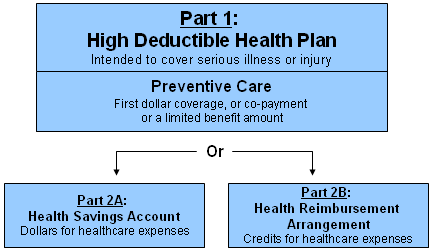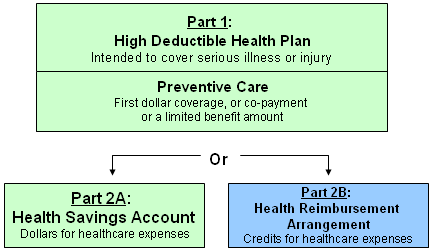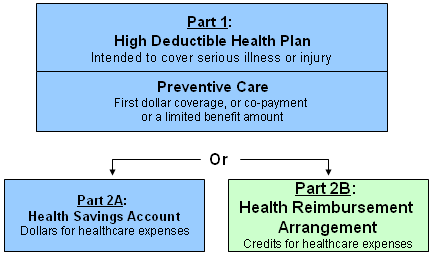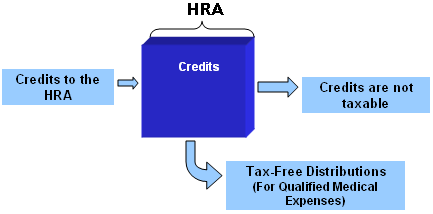|
|
High Deductible Health Plans (HDHP) and Open Season
High Deductible Health Plans – Part 1

We have divided the presentation into 3 parts. We will begin by talking
about High Deductible Health Plan (Part 1). These are plans intended to cover serious
illness or injury; Preventive Care - First dollar coverage; or co-payment or a limited benefit amount.
We will move on to the role of health savings accounts (Part 2A), and health reimbursement
arrangements (Part 2B).
The Basics of High Deductible Health Plans
- High Deductible Health Plans (HDHP) provide insurance coverage.
- Service delivery in HDHP programs may be offered with a:
- Preferred Provider Organization (PPO)
- Health Maintenance Organization (HMO)
- Point of Service (POS)
- Depending on the HDHP, you may have the choice of using in-network or out-of-network providers. Using in-network providers will save you money.
- With the exception of preventive care, the annual deductible must be met before plan benefits are paid.
- An exception is made for preventive care services which are paid after a small deductible or co-payment. A maximum dollar amount (up to $300, for instance) may apply.
- An HDHP with a Health Savings Account (HSA) or a Health Reimbursement Arrangement (HRA):
- Helps to build savings for future medical expenses
- Allows greater flexibility over how you use your health care dollars
- For 2007, HDHPs must have minimum deductibles of:
- $1,100 for Self-Only coverage
- $2,200 for Self and Family coverage
- HDHPs have higher annual out-of-pocket limits than many plans. The maximum in-network, out-of-pocket limits for HDHPs in the FEHB Program are:
- $5,500 for Self coverage
- $11,000 for Self and Family coverage

Health Savings Account – Part 2A

Part 2A: Health Savings Account -- Dollars for healthcare expenses."
The Basics of a Health Savings Account

Funding Your HSA
Eligibility for a Health Savings Account
- By law, you must enroll in an HDHP to be eligible for an HSA.
- By law, you are not eligible for an HSA if you:
- are enrolled in Medicare,
- are covered by another health care plan that is not an HDHP,
- can be claimed as a dependent on someone else's tax return,
- are enrolled in a general Health Care Flexible Spending Account (or covered by a spouse's FSA),
- are covered by a non-HDHP such as TRICARE and TRICARE For Life, or
- are covered by VA benefits and have used VA medical services within the previous 3 months.
- The HDHP helps you determine your eligibility for an HSA.
- If you do not qualify for an HSA, your HDHP will establish a Health Reimbursement Arrangement (HRA) for you.
The Features of a Health Savings Account

Basically, this is how HSAs work.
The health plan deposits a 'premium pass through';
and you can make voluntary contributions.
There is no tax on the 'premium pass through.'
Your voluntary contributions are recorded on your tax form (such as a 1040)
as a tax deduction (applies with either itemized or standard deduction).
These two contributions can earn tax-free interest. You can use this money for qualified medical expenses.
The money can also be used for non-medical expenses but
you have to pay regular tax and a 10% tax penalty if you are younger than 65.
- Tax-deductible contributions
- Your own HSA contribution – your own HSA contributions are either tax-deductible or pre-tax (if made by payroll deduction).
- Annual contributions may be made any time during the calendar year up to April 15 of the following year (tax return due date).
- The health plan's "premium pass through" is not taxable.
- The annual maximum contribution is established by law.

Catch-Up Contribution to HSA
In addition to the maximum contribution, (the plan's annual deductible)
individuals between the ages of 55 and 65, can make "catch-up"
contributions to the HSA each year.
| Year |
Amount |
| 2008 |
$900 |
| 2009+ |
$1,000 |
- Tax-free withdrawals for "qualified medical expenses."
- Qualified medical expenses include:
- Dental treatment such as fillings, braces, extractions
- Hearing aids including batteries
- Prescription drugs and over-the-counter drugs
- Eye exams, eyeglasses and contact lens
- Premiums for qualified long term care insurance (dollar limits may apply)
- Out-of-pocket expenses including deductibles, coinsurance and co-payments
- Acupuncture
- Tax-free interest
- Interest accrues on the HSA balance.
- Rollover of funds
- Unused funds and interest carry over, without limit, from year to year.
- Portability
- The HSA is yours to keep—even when you retire, leave the Federal government, or change health plans.
- Funds held with a qualified trustee or custodian
- Example: Bank, insurance company, Federal credit union. The FEHB member may select a different trustee or custodian for voluntary contributions.

Other Types of Insurance Coverage
- Insurance Allowed with an HSA:
- Accident
- Disability
- Dental care
- Vision care
- Long-term care
- Specified disease or illness
- Insurance that pays a fixed amount per day of hospitalization
- Limited HCFSA
- Insurance or Accounts Not Allowed with an HSA:
- General Health Care Flexible Spending Account (HCFSA) or a Spouse's
FSA
- Medical coverage by a non-HDHP
- TRICARE or TRICARE For Life
- Any VA benefits used within previous 3 months
- Part A and/or Part B Medicare
Determining the Maximum Allowable Contribution to an HSA Account
The maximum allowable contribution is determined by the HDHP's effective date.
If your HDHP was effective January 1st, the total amount you can contribute to your account is the maximum contribution amount set by the IRS.
- If your HDHP is effective after the first day of the month, you may make or recieve a full year's contribution to your HSA for partial year coverage as long as you maintain your HDHP enrollment for 12 months.
- If you do not maintain your enrollment in an HDHP for 12 months, your maximum contribution amount is pro-rated based on the number of full months your HDHP was in effect.

HSA Distribution Process
- HSA trustees or custodians are not required to determine whether HSA distributions are used for qualified medical expenses.
- Individuals who establish HSAs should maintain records of medical expenses to show distributions have been made exclusively for qualified medical expenses should the IRS request them..
- Each HSA trustee will have specific instructions on the qualified distribution of qualified or non-medical expenses.
Health Reimbursement Arrangement – Part 2B

The Basics of a Health Reimbursement Arrangement
- An HRA is a savings credit that works hand-in-hand with an HDHP.
- The HDHP credits a portion of the health plan premium to the HRA (some
plans will credit the annual amount at the beginning of the plan year).
- The HDHP helps determine eligibility. If you are not eligible for
an HSA, your health plan will enroll you in an HRA.
- A limited HRA (called a Personal Care Account) is also available with
Consumer Driven health plan.
The Features of a Health Reimbursement Arrangement
- Tax-free withdrawals for qualified medical expenses only. Must provide documents of medical expense to health plan.
- Carryover of unused credits from year to year.
- Credits in an HRA do not earn interest.
- Credits in an HRA are forfeited if you switch health plans or leave Federal employment, except for retirement.
- Voluntary contributions to an HRA are not allowed.
- HRAs are more limited on tax advantages, forfeitures, expense distribution, and voluntary contributions than HSAs.

The Differences Between an HSA and HRA
| Benefits |
HSA |
HRA |
| Interest? |
Yes. |
No. |
| Tax-deductible contributions to your account? |
Yes. |
No. |
| Withdrawal of funds for non-medical purposes? |
Yes, subject to tax; and penalties prior to age 65 |
No. |
| Portable? |
Yes. You own your account. |
No. Your account is forfeited if you leave the sponsoring health
plan or leave the government (except for retirement). |
Health Care Flexible Spending Account (HCFSA). Dependent Care Flexible Spending Account (DCFSA)
Will an HCFSA and/or an DCFSA affect the member's eligibility to an HSA or HRA?
- A DCFSA is permitted with an HCFSA, HSA or HRA.
- A Limited Expense HCFSA is allowed with an HSA
- An FSAFEDS HCFSA is permitted with an HRA.
- An FSAFEDS general purpose HCFSA is not allowed with an HSA.
What is a limited Expense Health Care Flexible Spending Account?(LEX HCFSA)?
- An FSA option available to employees who are enrolled in FEHB HDHP with an HSA.
- Expense are limited to dental and vision care services/products that meet IRS definition medical care.
- You can set aside anywhere from a minimum of $250 to $5000 per year.
- You can enroll in an LEX HCFSA during the FSAFEDS Open Season. Go to www.FSAFEDS.com and select Enroll Now to enroll.
Features of a Health Reimbursement Arrangement

This is how an HRA works.
The health plan makes credits to the HRA. These credits are not taxable. You can make tax-free distributions from your HRA for qualified medical expenses.
Let's take a look at how the entire process works for HSAs and HRAs.
Example of an Enrollment, Set-Up, Contribution, and Distribution Process
- Open Season election form completed by FEHB member.
- HDHP/HSA or HRA set-up begins with receipt of enrollment form.
- Trustee/custodian/or health plan paperwork sent to FEHB member.
- The first "Premium Pass Through" deposited to the HSA, or credits to HRA by the health plan.
- Trustee/custodian paperwork completed by the FEHB member & returned to health plan.
- Only medical expenses incurred on or after the HSA or HRA is set-up are reimbursable through distributions.
- Enrollee may begin voluntary contributions after the HSA is set-up.

List of High Deductible Health Plans
GEHA and Mail Handlers are available nationwide.
| Plan |
Parts of: |
| Advantage Health Solutions |
Indiana |
| Aetna HealthFund |
Alaska, Alabama, Arkansas, Arizona,
California, Colorado, Connecticut, Delaware,
District of Columbia, Florida, Georgia,
Idaho, Illinois, Indiana, Kansas, Kentucky, Louisiana,
Maine, Maryland, Massachusetts, Michigan, Mississippi, Missouri,
North Carolina, Nevada, New Hampshire, New Jersey, New York,
Ohio, Oklahoma, Pennsylvania,
South Carolina, Tennessee, Texas, Vermont, Virginia,
Wisconsin, Washington, West Virginia |
| Plan |
Parts of: |
| Altius Health Plans |
Idaho, Utah |
| AultCare |
Ohio |
| Blue Cross Blue Shield Service Benefit Plan |
Kansas, Missouri, Minnesota, Ohio, Tennessee |
| Bluegrass Family Health, Inc |
Indiana, Kentucky |
| CDPHP Universal Benefits |
New York |
| Coventry Health Care |
Delaware, Georgia, Iowa, Kansas, Louisiana,
Maryland, Missouri, New Jersey, Pennsylvania |
| Fallon Community Health Plan |
Massachusetts |
| Group Health Plan |
Illinois and Missouri |
| Health Alliance HMO |
Iowa, Illinois, Indiana |
| Health Alliance Plan |
Michigan |
| HealthAmerica |
Pennsylvania |
| Kaiser Foundation Health Plan of Georgia |
Georgia |
| OSF Health Plans |
Illinois |
| Piedmont Community Healthcare |
Virginia |
| TakeCare |
Guam |
| Unicare HMO |
Illinois and Indiana |
| Universal Care of California |
California |
Resources: Search the Web, Refer to the 2008 Plan Brochures and 2008 Guides

|





